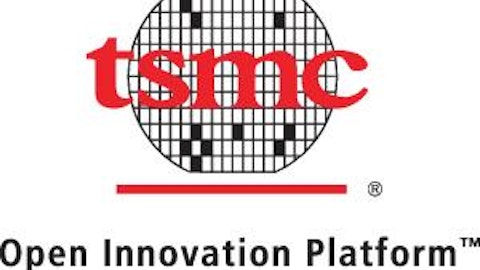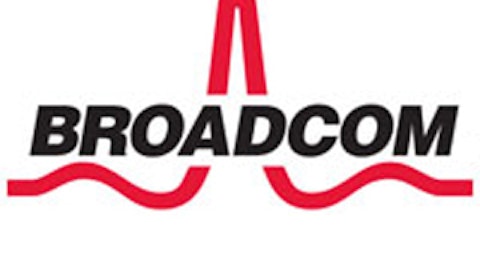
Intel doesn’t fail at creating faster processors. In fact, the company has done an excellent job of doing that, and in fact, it should continue to do that. The problem that Intel Corporation (NASDAQ:INTC) faces as every other maturing technology company is identifying growth opportunities in the space.
Some have speculated that the company will become a pure-play-fabrication (a company that focuses purely on accepting other people’s semiconductor designs and manufacturing it for them). Other more vocal optimists continue to boast about Intel’s potential in the mobile processing space.
So, in this article, I am going to explore whether or not the company can compete in pure-play-fabrication, or in the mobile space.
Pure-play-fabrication
When I think of pure-play-fabrication, I think of Taiwan Semiconductor Mfg. Co. Ltd. (NYSE:TSM). The company provides a flexible manufacturing process that allows for different levels of production output.

The company’s manufacturing is flexible as it allows companies to come to them with a small order of 10,000 wafers within a single month (represent approximately 1.7 million chips to be fair). So what gives Taiwan Semiconductor Mfg. Co. Ltd. (NYSE:TSM) a competitive advantage isn’t its ability to produce the fastest processors in terms of transistor counts (which is crucial), but because of the practicality of the solution.
The problem with Intel Corporation (NASDAQ:INTC)’s attempt to enter into the pure-play-fabrication space is that it isn’t very profitable for Intel to retrofit its fabrication facilities for a variety of different type of integrated circuits. Intel’s fabrication facilities are designed for x86 chips, whereas Taiwan Semiconductor Mfg. Co. Ltd. (NYSE:TSM) can manufacture any type of integrated circuit and even in smaller quantities (1.7 million integrated circuits), which is enough to lower the barrier of entry for companies to manufacture silicon for their own special needs.
Nowadays, there’s an integrated circuit in anything. That may include cars, air conditioning, refrigerators etc. Not every computer has to process complex commands to be a computer, and it is a fact of life that computing doesn’t have to revolve around x86. This is what gives Taiwan Semiconductor Mfg. Co. Ltd. (NYSE:TSM) a clear lead in manufacturing silicon for other companies that Intel Corporation (NASDAQ:INTC) may not have.
Mobile
QUALCOMM, Inc. (NASDAQ:QCOM) is another one of those companies that have built up a significant competitive advantage in their own respective space. What Intel doesn’t have is the near endless amount of experience QUALCOMM, Inc. (NASDAQ:QCOM)engineers have when designing mobile computing processors and 4G LTE chipsets.
There are two main-types of mass produced processors in the world. The one for mobile generally runs on the ARM design. The one for desktop and Laptop computing is x86. Intel Corporation (NASDAQ:INTC) is very proficient at designing 64 bit chips. The trouble is when Intel enters into the mobile space designing chips from the context of x86 rather than ARM. ARM chip designs are extremely compatible with Android and iOS. Meaning that if Intel really wants to compete in the space, than it has to design chips that run on the ARM architecture.
Therefore, Intel Corporation (NASDAQ:INTC) is designing x86 chips that are generally less power efficient, but it at least adheres to what Intel knows how to do. As a result, Intel has to woo developers to accept a x86 chipset design over an ARM even though Android and Apple mobile ecosystem’s have been built on an ARM-based design. Generally speaking, better benchmarks are meaningless if Android programs and application aren’t fully optimized for an x86 processor. 95% of smartphones currently operate using the ARM chip design, meaning that Intel’s gain in market share could be limited even if it were to design a faster processor.
ARM-based processors are practical in that they sip less battery, it’s a complete system on a chip which means higher yields in the fabrication process, Most phone developers would choose the practicality of having a power-efficient processor, with higher yields, over a more powerful processor that may not be fully supported by certain programs.
Problems that must be addressed
Intel Corporation (NASDAQ:INTC)’s Paul Otellini resigned in the fourth quarter of 2012. He has an MBA from the Haas School of Business (California Berkley). Looking closely at Mr. Otellini’s education background, it is highly likely that he thought that Intel’s business positioning was awful. It is likely that the CEO at the time realized the same things you realized in this article, that Intel could thrive in its specific niche of x86 chips, but when it comes to being a semiconductor company outside of its core area of strength, it does extremely poorly.
In Intel Corporation (NASDAQ:INTC)’s latest quarter, it was unable to turn around all the idle capacity in its fabrications running at 50% capacity. It doesn’t help that the company’s mobile offerings (Atom) were unable to win any significant market share from its rivals like QUALCOMM, Inc. (NASDAQ:QCOM) and ARM Holdings plc (NASDAQ:ARMH). Likewise, the company doesn’t provide a practical business solution in the pure-play-fabrication space.
Just because a company has some of the best engineers in the world does not mean they can come up with the best processing solutions for mobile overnight. In fact, it is like taking a group of pro NFL players and retro-fitting them into NBA players. The thought is so laughable; I thought I’d make the comparison of Intel x86 engineers becoming ARM-based engineers.
Conclusion
Investors shouldn’t get their hopes too high. Intel Corporation (NASDAQ:INTC) is unlikely to capture any serious market share in either the mobile or the pure-play fabrication space. Hence, analysts have been neutral to bearish on the stock. Declining desktop demand adds further to Intel’s troubles.
Investors should invest into Taiwan Semiconductor Mfg. Co. Ltd. (NYSE:TSM) or QUALCOMM, Inc. (NASDAQ:QCOM) instead.
The article Can Intel Compete With These Titans? originally appeared on Fool.com.
Alexander is a member of The Motley Fool Blog Network — entries represent the personal opinion of the blogger and are not formally edited.
Copyright © 1995 – 2013 The Motley Fool, LLC. All rights reserved. The Motley Fool has a disclosure policy.

